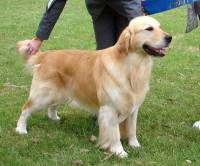Flat Coated Retrievers
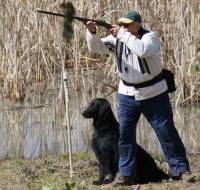 Flat Coated Retriever
Flat Coated Retriever
In the early 1800's some of the Retrieving dogs that came across from the Labrador region of Canada, landed at Poole, in the southern Region of England. There were bred with Setting Spaniels. These crosses produced the Wavy or Flat Coated Retriever that was to become extremely popular by the second half of the 1800's.
History of the Flat Coated Retriever
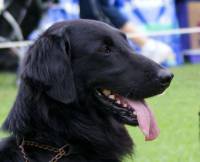 Flat Coated Retriever
Flat Coated Retriever
Once the shotgun became more affordable, game or birds that were shot were often left crippled. Often it would land some distance away from and often out of the sight of the shooter, obscured by dense undergrowth. So a trained retrieving dog was developed. This dog would restrain his natural instinct to chase until, on command, he would find and retrieve dead or injured game without harming it. So a specialised soft mouthed retriever was developed that could find the shot game on land or maybe also in water.
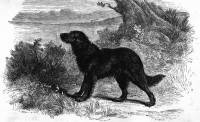 Wavy (Flat) Coated Retriever c 1870
Wavy (Flat) Coated Retriever c 1870
Most of the gundogs could be taught by patience and practice to retrieve fur or feather, but game carefully and skilfully shot is easily rendered valueless by being mauled by powerful jaws not schooled to gentleness. And this question of a tender mouth was certainly one of the problems that perturbed the minds of the originators of the breed. The difficulty was overcome by a process of selection, and by the exclusion of all hard-mouthed specimens, with the happy effect that in the present time (1907) it is exceptional to find a hard working Retriever who does not know how to bring his bird to hand without injuring it[1].
The Flat Coated Retriever becomes a Pure Breed
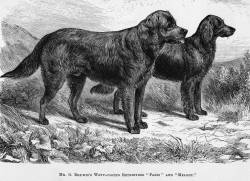 Wavy (Flat) Coated Retrievers c 1872
Wavy (Flat) Coated Retrievers c 1872
By 1860 the first classes for Retrievers were held at Birmingham followed by the first Field Trial in 1866. The more wealthy sportsmen of that time, keen to succeed at both Field Trials and Shows with the same dog, set about creating a truly dual-purpose dog. The Flat Coated Retriever was popular in the late 1800's on the large shooting estates.
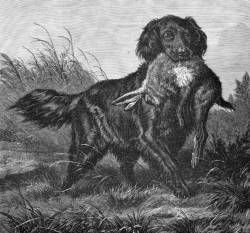 Wavy (Flat) Coated Retriever c 1880
Wavy (Flat) Coated Retriever c 1880
The founder of the Kennel Club (UK), Mr S. E. Shirley, who was its Chairman from 1873 to 1899, was a great enthusiast of the Flat Coated Retriever and helped stabilize the breed type. The Flat Coated Retriever breed standard was first drawn up in 1923 and approved by the Kennel Club (UK). It was clarified by the Flat-Coated Retriever Society in 1977 with only slight variation from the original[6].
History of Flat Coated Retrievers in Australia
 Flat Coated Retriever
Flat Coated Retriever
The catalogues of the first dog show held in Melbourne in 1864[3] lists sixteen Retrievers with no indication of coat colour or type. However, Tyzack's Annual lists two Wavy Coated Retrievers as being imported from Britain. These were 'Punch 11' in 1882 imported by Rev. W.J.Richardson and a bitch called 'Hal Di' which, a decade later in 1893, went to L.C.Mackinnon[4]. In October 1914, the 'Leader Newspaper' also reported two imports which went to a Mr Hanna of Donald, a country town in Victoria. However, none of these left any significant progeny.
Then Mr Christie of Dubbo (in country NSW) imported 'Wisdom of Woodblue' ('Punch') and Marjorie of Macquarle ('Judy') which were purchased for him by Mr Jack Crawford, the tennis player. These came from the London Emporium of Harrods and brought to Australia on a ship called the 'Ceramic'. Used to shoot waterfowl, they also produced the first documented litter of Flat coats in Australia[9].
However, the Flat Coat did not really make its presence felt until 1974 when Faye and Robert Pargetter imported a dog and bitch from England. When Dorothy Sutch imported another bitch from the same famous English Stonemead kennel, a litter was born that sparked incentive to establish the Flat coated Retriever here[5a]. This has been followed by a steady but small stream of Flat Coats from overseas which have kept the Flat Coat alive in Australia.
Comparison between the Golden, Flat Coat and Curly Coated Retrievers
A convenient way to study the similarities and differences between these three Retrievers, is by a the comparison table below:
| Golden Retriever | Flat Coated Retriever | Curly Coated Retriever | |
|---|---|---|---|
|
|
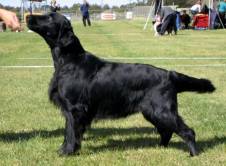 Flat coated Retriever Flat coated Retriever |
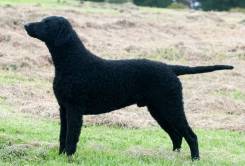 Curly Coated Retriever Curly Coated Retriever |
|
| General Appearance | Symmetrical powerful but well balanced cream or gold dog with a kindly expression | Medium sized black or liver elegant dog showing power without lumber and raciness without being weedy. | The tallest of all the retrievers, an upstanding, strong black or liver dog with a distinctive curly coat |
| Size | Height: Dogs 56-61 cms (22-24 ins) Bitches 51-56 cms (20-22ins) | Height: Dogs 58-61 cms (23-24 ins) Bitches 56-58cms (22-23 ins) Weight: Dogs 27-38 kg (60-80 lbs) Bitches 25-32 kg (55-70 lbs) | Height: Dogs 69 cms (27 ins) Bitches 64 cms (25 ins) |
| Colour
|
From the palest cream to the deepest yellow is equally acceptable as long as it is neither red nor mahogany. | Black or liver | Black or liver |
| Coat | Double coated with a thick water resistant undercoat and a flat or way top coat without curl, giving the coat a somewhat harsh feel. The feathering coat sometimes needs trimming which is acceptable. | The coat should be as flat as possible and although dense, should never be curly. His elegant outline is completed by his medium textured good quality coat and the feathering behind his legs and on the tail. | The body, neck and tail should never have any thin or bald patches. Instead the dog is completely covered in small tight-knit screw astrakhan type water-resistant curls that feel oily and crisp. |
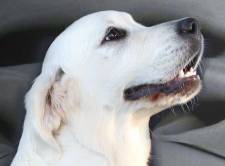 Golden Retriever Golden Retriever |
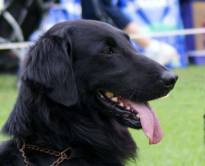 Flat Coated Retriever Flat Coated Retriever |
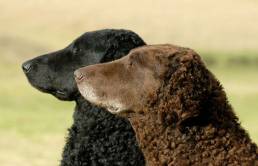 Curly Coated Retrievers Curly Coated Retrievers |
|
| Head | Without being coarse, the skull is broad and slightly rounded, and the very strong, wide and deep muzzle should not have too much flew. The length of the muzzle should equal that of the skull and the nose should be black. | The skull is long and looks moulded with a strong muzzle the same length as the skull. This head should be sufficiently strong to be capable of carrying a hare. The large nose should have open nostrils. | The head is wedge-shaped when viewed from either the side or the front. The skull and muzzle are of equal length with parallel head planes. The lips are tight and the nose black or liver depending on the coat colour. |
| Stop | Well defined | Slight | Slight |
| Eyes | Size to balance the head, set wide apart to give a soft, kindly expression, dark brown with tight dark rims | Medium sized but not obliquely set, dark brown or hazel with an intelligent expression | Large but not prominent, oval in shape and obliquely set. Dark brown in blacks but in livers colour to blend with coat. |
| Ears | Moderate size, set on approximately level with the eyes | Small and set on close to the head | Rather small and set on slightly above the level of the eye |
| Mouth | Normal scissors bite | Normal Scissors bite | Normal scissors bite |
| Neck | Of sufficient length to balance the body and clean (without dewlap) | Fairly long without dewlap | Medium length and slightly arched, without dewlap |
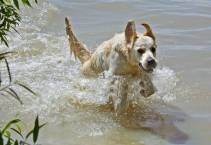 Golden Retriever Golden Retriever |
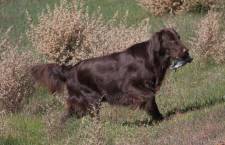 Flat Coated Retriever Flat Coated Retriever |
 Curly Coated Retreiver Curly Coated Retreiver |
|
| Body | The correct balance of body is slightly longer than Height at withers. In depth it should measure the same from withers to elbow as elbow to ground. The chest has a prominent but not exaggerated prosternum | Balanced with a level topline and long deep ribcage with moderate tuck-up. The fore ribs are fairly flat, the centre ribs more arched but they become rather lighter towards the hindquarters. Deep chest with brisket well-defined | Slightly longer than height at withers with well spring ribs and deep brisket. As the Curly is an upstanding dog, it is important that the ribs reach the elbows but does not extend beneath them |
| Front | The Golden has a good lay of shoulder with the shoulder blade and humerus being of equal length. This places the elbows well under the body. The forelegs should be straight with good bone and only a slight slope of pastern | The shoulders are obliquely set, the and the forelegs perfectly straight with good quality bone and flexible pasterns | The Curly has well laid shoulders and shoulder blade and humerus of equal length. The legs are straight with round bone and strong, flexible pasterns |
| Feet | Round and cat-like | Round and strong with well arched toes | Round and tight with well arched toes with some webbing in between them |
| Hindquarters | Strong and muscular with a good turn of stifle and short straight hocks neither turned in nor out | Muscular with moderate turn of stifle and straight hocks so he dog stands true | Powerful muscular hindquarters with moderate turn of stifle to give the dog overall balance |
| Tail | Set on and carried level with the back, strong and covered with thick coat, it should be straight and never curled or hooked | Set straight off topline, the tail itself should be short and straight | Flows from a slightly sloping croup, thick at the root and tapers to a point and is completely covered with short curls |
 Golden Retriever Golden Retriever |
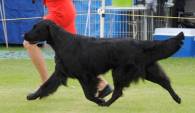 Flat Coated Retriever Flat Coated Retriever |
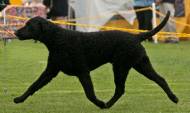 Curly Coated Retriever Curly Coated Retriever |
|
| Gait | Powerful with long and true stride | Free, flowing and true front and back | Effortless, powerful gait with good extension |
References and Further Reading
Hot off the Press! Jane has just published a book 'Gundogs Unveiled'. Information on our sister website: www.Rangeairevision.com
[1] "Cassell's New Book of the Dog" by Robert Leighton assisted by eminent authorities on the various breeds. Published 1907 by The Waverley Book Co Ltd. Vol II, Chapter XXV L.P.C. Astley, "The Flat-Coated Retriever" Part 1 Page 225
[2] Joan Tudor, "The Golden Retriever" published by 'Popular Dogs' publishing Co Ltd 3 Fitzroy Square, London W1 ISBN 0 09 129360
[3] "Catalogue of the First Exhibition of Sporting & Other Dogs", Thursday & Friday April 7 & 8, 1864 promoted by the Council of the Acclimatisation Society, printed in Melbourne by Mason & Firth, Printers, Flinders Lane West Page 5
[4] " Tyzack's Annual" Compiled by T. W.Tyzack and C.S.Turner Published by the Victorian Poultry and Kennel Club Printed in 1912 by Bellamine Bros. Printers, 66-70 Flinders Lane Melbourne Pages 81 and 89
[5] " The History of Purebred Dogs in Australia" published by OzDog Newspaper 1997
[5a] Ibid., "The Flat Coated Retriever" by Peter Kennon Page 137
[5b] Ibid., "The Curly Coated Retriever" by Vicki Knowles Page 107
[5c] Ibid., "The Golden Retriever" by Beryl Hession Page 161
[6] Dr Nancy Laughton, "A Review of the Flat-coated Retriever" Self-Published 1968 Introduction Pages 17-20; The current Breed Standard and its Amplification Page 69.
[7] Rev. Thomas Pearce Alias 'Idstone' 'The Dog' Published by Cassell, Petter and Galpin London 1872 Chapter XV The Curly-Coated Retriever Page 130
[8] W M Charlesworth, 'Golden Retrievers' Published by Williams & Norgate Ltd London 1952 Chapter 1 History Pages 13 - 19
[9] The Sydney Morning Herald 20 February 1937
